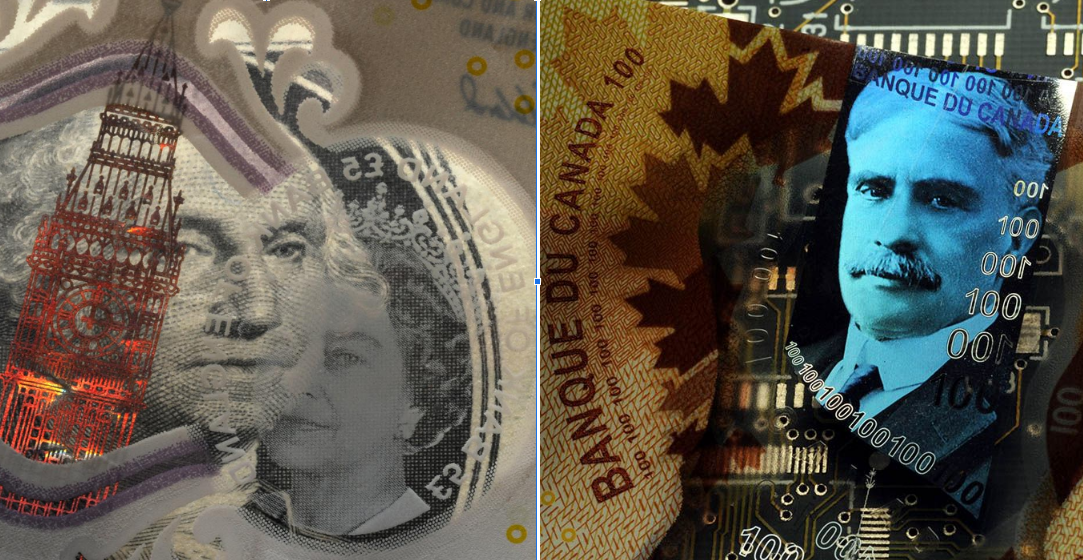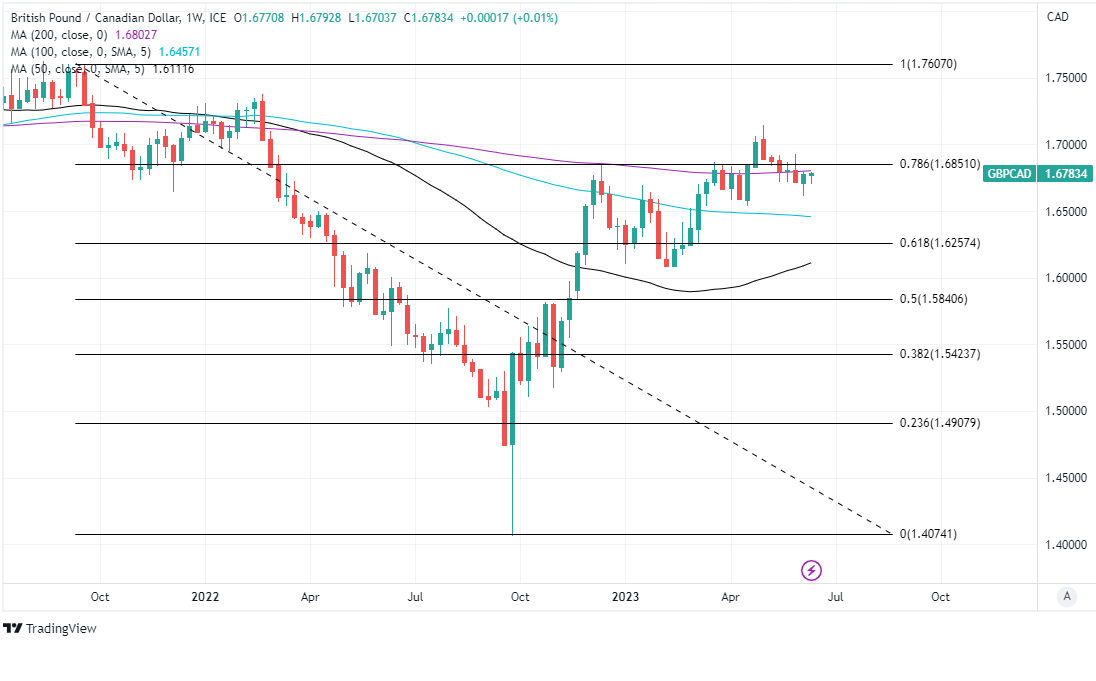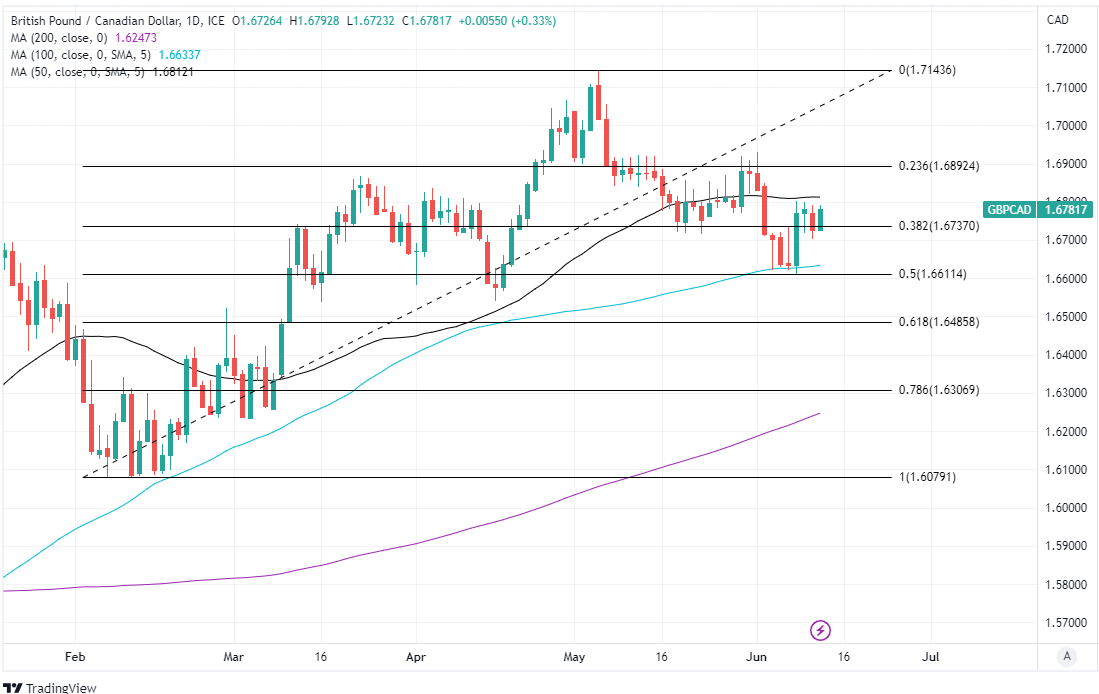Pound-Canadian Dollar Strength to Remain Limited Near-term
- Written by: James Skinner
-
"There is still another jobs report, the May CPI report, and the BoC's own closely watched Business Outlook Survey out before the next interest rate decision - and we continue to expect data releases to look softer as time goes on" - RBC Capital Markets.

Image © Pound Sterling Live
The Pound to Canadian Dollar exchange rate has rebounded from early June lows in recent trade though remains within the 1.66 to 1.6950 range prevailing over the last six weeks while economic data from the UK and Canada have offered little impetus for a breakout in either direction.
Canada's Dollar edged higher against half the G20 basket on Tuesday but gave ground to the Pound after Office for National Statistics (ONS) figures painted a mixed picture of the UK labour market with echoes of the data released over in Canada just last Friday.
The ONS reported a strong rise in employment for the three months to April and the largest increase in wage growth outside of the pandemic, which has reportedly left the average pay packet down somewhere between 1.3% and 2% in real or inflation-adjusted terms for the year to the end of April.
"April’s large rise might partly reflect low-pay employers responding to the 9.7% increase in the National Living Wage at the start of the month. Note that seasonally-adjusted wages in the wholesaling, retailing, hotels & restaurants sector increased by 0.7%," says Samuel Tombs, chief UK economist at Pantheon Macroeconomics.
"Nearly half of the 250K rise in employment in the three months to April was driven by a rise in self-employment; full-time employee numbers rose by just 43K, or 0.2%. In addition the PAYE data point to a clear stabilisation in labour demand," he adds in response to the figures.
Above: Pound to Canadian Dollar rate shown at daily intervals with selected moving averages denoting possible technical support and/or resistance while Fibonacci retracements of March rally indicate prospective support for Sterling. Click for closer inspection.
April's data also suggested a rise in unemployment "driven by people unemployed for up to 12 months," however, which lifted the quarterly unemployment rate from 3.7% to 3.8% while the more timely unemployment-related welfare claims numbers suggested a further increase to 3.9% could be likely in May.
The data was followed by another rally in UK government bond yields and an uplift in market-implied measures of expectations for the Bank of England (BoE) Bank Rate, which have recently climbed above 5%; dragging UK mortgage rates higher with them and acting as a de facto increase for Bank Rate along the way.
"I would argue the BOE doesn’t need to “be hawkish” from these levels. For example a two year mortgage deal across a range of LTV ratios rose to 5.82% on Friday (Reuters)," says Jordan Rochester, an FX strategist at Nomura.
Current levels of expectations for interest rates weighed heavily on Sterling when they were last this high back in September 2022, making them a potential risk for the currency up ahead and particularly if the BoE follows through by raising the benchmark aggressively next week.
This might be especially so for GBP/CAD in light of market pricing of the outlook for the Bank of Canada (BoC) cash rate, which has closed the gap with expectations of the BoE following the labour market data out in Canada on Friday and the latest interest rate decision last Wednesday.
"This week is lighter on the domestic calendar than last week though CAD OIS is now pricing in 18bps and 11bps for the next two BoC meetings," writes Bipan Rai, North American head of FX strategy at CIBC Capital Markets, in a Monday market commentary.

Above: Pound to Canadian Dollar rate shown at weekly intervals with selected moving averages denoting possible technical support and/or resistance while Fibonacci retracements of 2021 fall denote possible areas of resistance. Click for closer inspection.
Last Friday's Canadian data suggested employment fell in April with the unemployment rate also ticking higher in continuation of a trend dating back to January.
"The labour market data is always volatile and the May report is the first downside surprise in a while. Still, there were earlier signs that cracks were forming under the surface," says Nathan Janzen, assistant chief economist at RBC Capital Markets.
"There is still another jobs report, the May CPI report, and the BoC's own closely watched Business Outlook Survey out before the next interest rate decision - and we continue to expect data releases to look softer as time goes on," he adds.
Previously, the BoC raised its cash rate from 4.5% to 4.75% on Wednesday following a six-month pause in a tightening cycle that lifted the benchmark from 0.25% last March.
It cited concerns inflation "could get stuck materially above the 2% target," after the annual measure ticked higher from 4.3% to 4.4% to interrupt a six-month downtrend.












